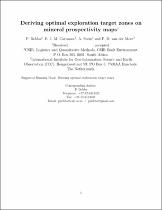JavaScript is disabled for your browser. Some features of this site may not work without it.
- ResearchSpace
- →
- Research Publications/Outputs
- →
- Journal Articles
- →
- View Item
| dc.contributor.author |
Debba, Pravesh

|
|
| dc.contributor.author |
Carranza, EJM

|
|
| dc.contributor.author |
Stein, A

|
|
| dc.contributor.author |
Van der Meer, FD

|
|
| dc.date.accessioned | 2009-02-24T12:32:46Z | |
| dc.date.available | 2009-02-24T12:32:46Z | |
| dc.date.issued | 2008-08 | |
| dc.identifier.citation | Debba, P, Carranza, EJM, Stein, A et al. 2008. Deriving optimal exploration target zones on mineral prospectivity maps. Mathematical Geosciences, Vol. (2009), pp 26 | en |
| dc.identifier.issn | 1874-8961 | |
| dc.identifier.uri | http://hdl.handle.net/10204/3068 | |
| dc.identifier.uri | http://www.springerlink.com/content/b40783jqj46r2h88/ | en |
| dc.description | This is the author's version of the work. It is posted here by permission of Springer Berlin for your personal use. Not for redistribution | en |
| dc.description.abstract | This paper describes a quantitative methodology for deriving optimal exploration target zones based on a probabilistic mineral prospectivity map. The methodology is demonstrated in the Rodalquilar mineral district in Spain. A subset of known occurrences of mineral deposits of the type sought was considered discovered and then used as training data, and a map of distances to faults/fractures and three band ratio images of hyperspectral data were used as layers of spatial evidence in weights-of-evidence (WofE) modeling of mineral prospectivity in the study area. A derived posterior probability map of mineral deposit occurrence showing non-violation of the conditional independence assumption and having the highest prediction rate was then put into an objective function in simulated annealing in order to derive a set of optimal exploration focal points. Each optimal exploration focal point represents a pixel or location within a circular neighborhood of pixels with high posterior probability of mineral deposit occurrence. Buffering of each optimal exploration focal point, based on proximity analysis, resulted in optimal exploration target zones. Many of these target zones coincided spatially with at least one occurrence of mineral deposit of the type sought in the subset of cross-validation (i.e., presumed undiscovered) mineral deposits of the type sought. The results of the study showed the usefulness of the proposed methodology for objective delineation of optimal exploration target zones based on a probabilistic mineral prospectivity map | en |
| dc.description.uri | http://www.springerlink.com/content/b40783jqj46r2h88/ | en |
| dc.language.iso | en | en |
| dc.publisher | Springer Berlin | en |
| dc.subject | Simulated annealing | en |
| dc.subject | Epithermal deposits | en |
| dc.subject | Weights-of-evidence | en |
| dc.subject | Hyperspectral remote sensing | en |
| dc.subject | Hydrothermal alteration | en |
| dc.title | Deriving optimal exploration target zones on mineral prospectivity maps | en |
| dc.type | Article | en |
| dc.identifier.apacitation | Debba, P., Carranza, E., Stein, A., & Van der Meer, F. (2008). Deriving optimal exploration target zones on mineral prospectivity maps. http://hdl.handle.net/10204/3068 | en_ZA |
| dc.identifier.chicagocitation | Debba, Pravesh, EJM Carranza, A Stein, and FD Van der Meer "Deriving optimal exploration target zones on mineral prospectivity maps." (2008) http://hdl.handle.net/10204/3068 | en_ZA |
| dc.identifier.vancouvercitation | Debba P, Carranza E, Stein A, Van der Meer F. Deriving optimal exploration target zones on mineral prospectivity maps. 2008; http://hdl.handle.net/10204/3068. | en_ZA |
| dc.identifier.ris | TY - Article AU - Debba, Pravesh AU - Carranza, EJM AU - Stein, A AU - Van der Meer, FD AB - This paper describes a quantitative methodology for deriving optimal exploration target zones based on a probabilistic mineral prospectivity map. The methodology is demonstrated in the Rodalquilar mineral district in Spain. A subset of known occurrences of mineral deposits of the type sought was considered discovered and then used as training data, and a map of distances to faults/fractures and three band ratio images of hyperspectral data were used as layers of spatial evidence in weights-of-evidence (WofE) modeling of mineral prospectivity in the study area. A derived posterior probability map of mineral deposit occurrence showing non-violation of the conditional independence assumption and having the highest prediction rate was then put into an objective function in simulated annealing in order to derive a set of optimal exploration focal points. Each optimal exploration focal point represents a pixel or location within a circular neighborhood of pixels with high posterior probability of mineral deposit occurrence. Buffering of each optimal exploration focal point, based on proximity analysis, resulted in optimal exploration target zones. Many of these target zones coincided spatially with at least one occurrence of mineral deposit of the type sought in the subset of cross-validation (i.e., presumed undiscovered) mineral deposits of the type sought. The results of the study showed the usefulness of the proposed methodology for objective delineation of optimal exploration target zones based on a probabilistic mineral prospectivity map DA - 2008-08 DB - ResearchSpace DP - CSIR KW - Simulated annealing KW - Epithermal deposits KW - Weights-of-evidence KW - Hyperspectral remote sensing KW - Hydrothermal alteration LK - https://researchspace.csir.co.za PY - 2008 SM - 1874-8961 T1 - Deriving optimal exploration target zones on mineral prospectivity maps TI - Deriving optimal exploration target zones on mineral prospectivity maps UR - http://hdl.handle.net/10204/3068 ER - | en_ZA |






